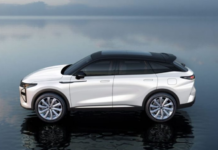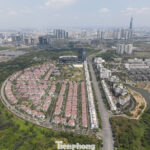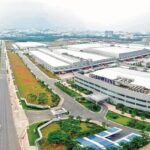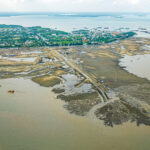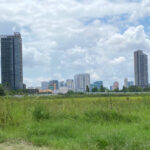On October 1st, the Ho Chi Minh City Department of Construction announced that it had submitted Document No. 9729 to the Ministry of Construction for review. The document addresses specific provisions in Circular 17/2025/TT-BXD, which outlines standards, methods, and cost management for urban and rural planning activities.
According to the Department of Construction, Circular 17/2025 issued by the Ministry of Construction sets cost standards for planning tasks and general urban planning, with a maximum area of 360,000 hectares. However, Ho Chi Minh City currently spans nearly 680,000 hectares.
Therefore, the Department of Construction proposes that the Ministry of Construction consider approving and providing guidance to expand the scale of general urban planning and planning for centrally-governed cities to 680,000 hectares. This adjustment aims to ensure legal compliance, facilitate administrative unit reorganization, and align with the practical requirements of Ho Chi Minh City’s development planning.
Based on the amended Law on Urban and Rural Planning, the Department of Construction recommends that the Ministry of Construction review and expand the cost standards for special urban areas. This includes introducing adjustment coefficients for cost standards applicable to multi-sector, multi-level integrated planning in special urban areas. The planning process should incorporate advanced technologies such as GIS, 3D modeling, and digital databases.

Following the merger, Ho Chi Minh City now covers nearly 680,000 hectares.
Since July 1st, Ho Chi Minh City has been designated as a special urban area following the merger of Binh Duong and Ba Ria – Vung Tau provinces. The city now spans approximately 6,800 square kilometers, with a population exceeding 14 million, comprising 168 wards, communes, and special zones.
According to the Ho Chi Minh City Institute for Development Studies (HIDS), the post-merger economic scale of Ho Chi Minh City exceeds 2.7 quadrillion VND, accounting for nearly one-quarter of the nation’s 2024 GDP. The city’s budget revenue is also impressive, contributing nearly one-third of the national total at 682 trillion VND.
The newly expanded Ho Chi Minh City boasts significant advantages in infrastructure connectivity, both domestically and regionally. Post-merger, Vietnam has five provinces and cities with two civilian airports each: Ho Chi Minh City, Da Nang, Gia Lai, Dak Lak, and An Giang. Ho Chi Minh City is home to Tan Son Nhat International Airport and Con Dao Airport, with a combined capacity of approximately 51 million passengers annually—the largest in the country. These airports play a pivotal role in driving tourism and cargo transportation.
In the future, this megacity will be directly linked to Long Thanh International Airport (with a capacity of 50 million passengers per year) via an expressway and urban rail system (metro).
Additionally, inheriting the logistics network from Ba Ria – Vung Tau, the new Ho Chi Minh City now hosts Vietnam’s largest port system, comprising 89 berths across three port clusters. This includes the world-class deep-water port at Cai Mep – Thi Vai.
Prior to the merger, Ho Chi Minh City was primarily a service-oriented urban area, with the service sector contributing over 65% of its 2024 GRDP. The economic structure of the new Ho Chi Minh City will shift, with an increased industrial share driven by the strengths of Binh Duong and Ba Ria – Vung Tau. The service sector’s contribution will decrease to 51.82%, while the industrial and construction sectors will rise from 22% to 35%. The remaining share comes from agriculture, forestry, fisheries, and product taxes.
Breaking News: Thaigroup Withdraws Proposal for Feasibility Study on Can Gio Bridge, Thu Thiem 4, and Phu My 2 Projects
Thaigroup has withdrawn its proposal to conduct research and execute investment projects for the construction of the Can Gio Bridge, Thu Thiem 4 Bridge, and Phu My 2 Bridge.
Condo Prices Outpace Townhouse Sales in the Real Estate Market
In the first eight months of the year, property prices in Eastern Saigon saw a notable surge, with private houses increasing by an average of 15%. However, the real standout was the apartment market, which experienced a remarkable 30% growth, doubling the rate of house price increases. Meanwhile, in Southern Saigon, apartments continued to outperform, with prices soaring by an average of 35%, while private houses saw a more modest 10% rise.
The Grand Vision: Vietnam’s 108-Story Tower to Rank Among the World’s Top 10 Tallest Structures
Rising 108 stories above the vibrant landscape of Can Gio, Vinhomes Green Paradise’s iconic tower stands as a new symbol of Vietnam’s ambition. More than just a landmark, it will serve as the region’s financial epicenter, pulsating with economic vitality.

